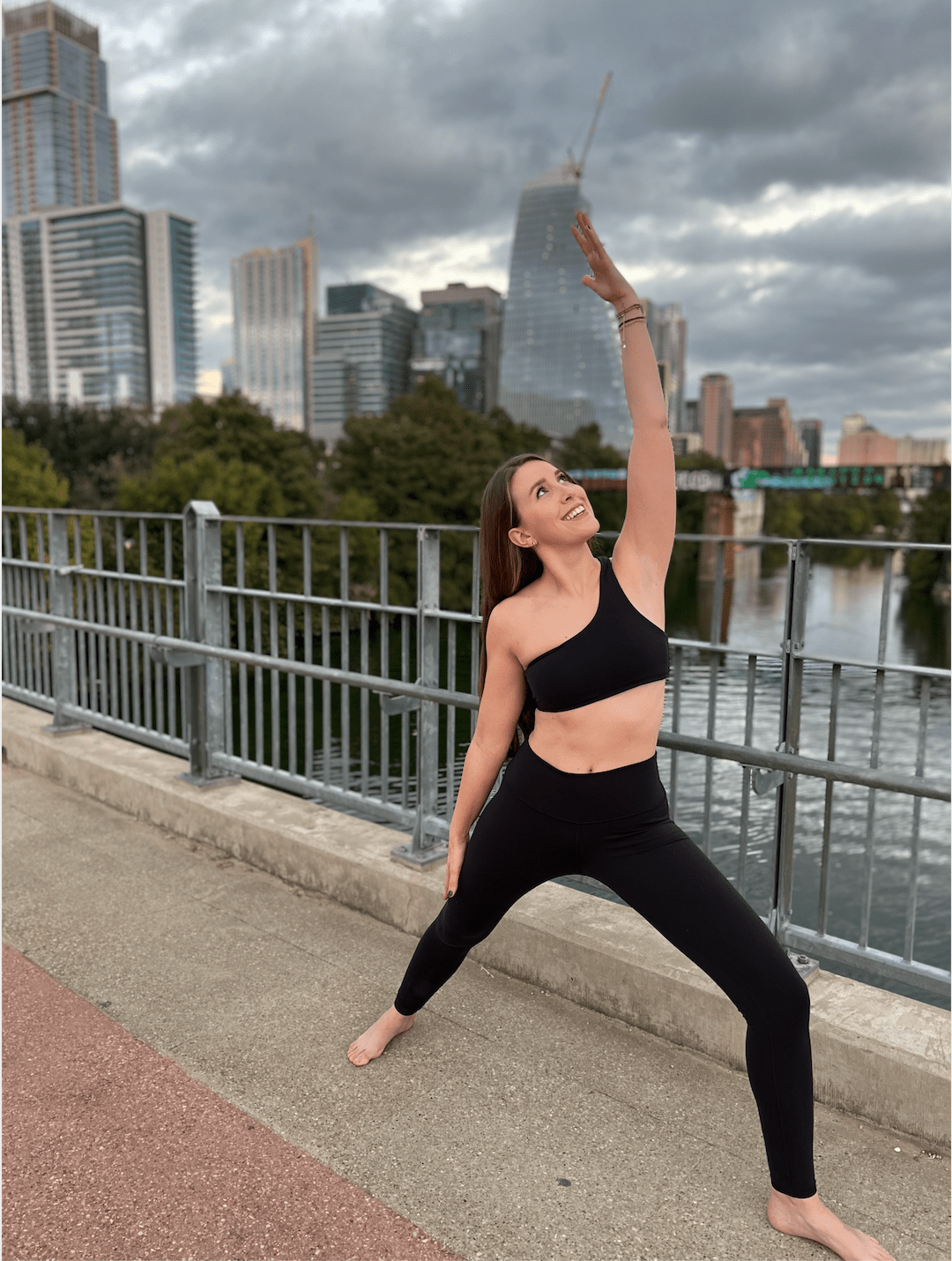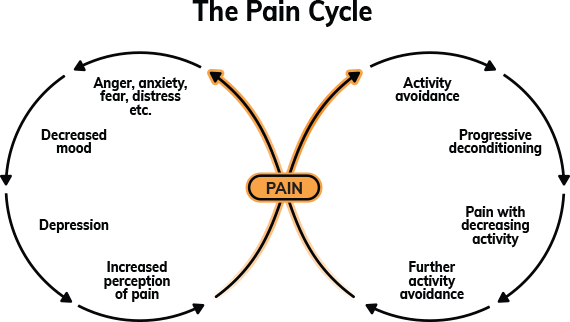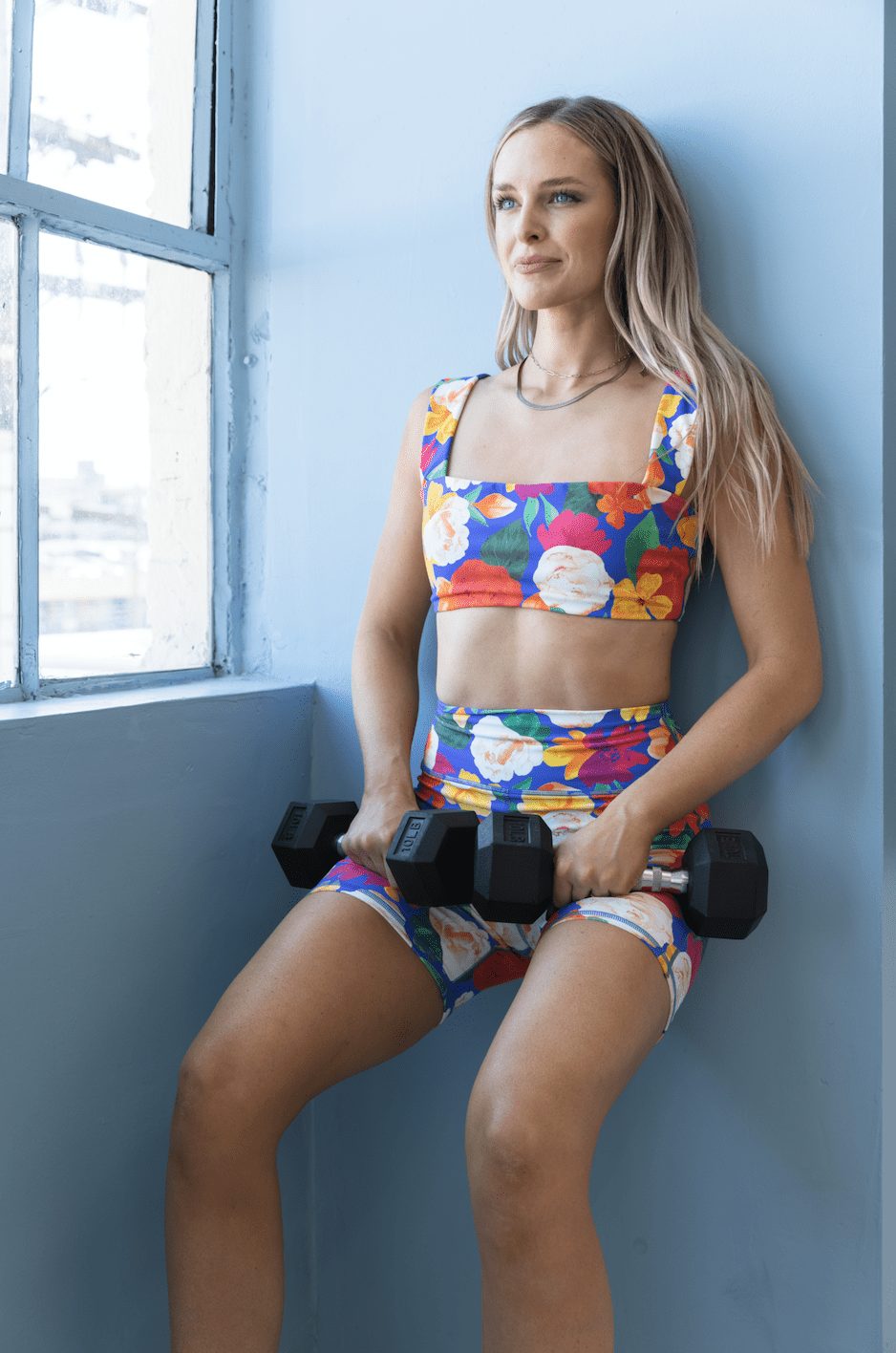Types of exercise
Recovery
Fitness myths
Evlo Programs
BODY COMPOSITION
All
Browse by category
Browse by category
How to use your thoughts and words to decrease pain and improve muscle growth
By: Dr. Payton Busker, PT, DPT
Hi y’all! Welcome to the Evlo Fitness blog.
My name is Dr. Payton and I’ll be bringing you a new blog each week spanning topics from why our thoughts and words matter as it relates to fitness to how to better recruit your glutes. For those of you who don’t know me, I am a Doctor of Physical Therapy, fitness professional, and Evlo’s new Head of Content.

Here at Evlo, we are all about building our bodies up, not tearing them down.
Because of this, we find ourselves in a unique space within the fitness industry. So much of the messaging within the fitness industry reads as follows:
- No pain, no gain
- If you could just burn more calories in your workouts, you could lose that extra 5 pounds
- If an exercise hurts, that probably means that your body needs it!
At least one or multiple of these probably sounds familiar to you if you’ve been a member of any sort of group fitness or had a personal trainer in the last 20 years. If you’re an Evlo member, you know we do things a littttle (read: a lot) differently around here. Today’s blog is all about how we use intentional language and thought processes to shake things up for the better! We are going to break down the power of language, especially as it pertains to pain, and address how positive visualization plays a role in strength training. I’ll present actionable steps along the way to help better your future workouts. Let’s dive in!
Many of our clients have found their way to Evlo after suffering with chronic pain and fatigue.
In early episodes of Dr. Shannon’s podcast “Fit Body, Happy Joints”, she covered many of the physical components that can lead to these issues. But what if I told you that the way you have talked about (and thought about) your body and your workouts could be a major contributor as well?
What we say to ourselves about our exercise and our bodies matters.
This might seem like a very basic and obvious statement. However, the things that I have heard both clients and patients say about their bodies and their fitness journeys leads me to believe that we aren’t actually integrating it into our daily lives.
Let’s take a look at the chronic pain cycle.
There are two parallel cycles that we can talk about when discussing chronic pain: the physical cycle and the mental cycle. These two cycles meet in the middle as “pain”.
Let’s check out the physical chronic pain cycle first.
When our brain perceives something as painful, we go into the first step of the physical cycle known as activity avoidance. Now this CAN be an advantageous response. Let’s say you step on a piece of glass and stop moving almost instantly without a conscious thought. This reflex is helpful and necessary to avoid getting the piece of glass further stuck in our foot. However, we run into trouble if a painful stimulus leads to a complete cessation of activity all together. Building on that piece of glass example, this would be you avoiding walking for the next month. This activity avoidance can lead to progressive deconditioning which in turn can lead to MORE pain with decreased activity. You are then on your way to more activity avoidance which leads you right back to the beginning of the cycle with more pain.
Now let’s break down the more psychological part of this chronic pain cycle.
Being in pain often leads us to feel a multitude of emotions including anger, anxiety, fear, distress (you know, allll the fun ones). In turn, we have a decrease in our mood followed closely by a potential increase in depression. Here’s where it gets interesting: depression is actually known to increase our perception of pain. And this leads us right back to where we started. Now you may be thinking “How exactly can what we say and think disrupt this cycle??”. Let’s take a look at how we can use words to do just that.

Image taken from https://reachforthefacts.com.au/what-is-pain/
There are few concepts that we can implement to accomplish this seemingly daunting task.
The process for breaking the pain cycle can start even before we step on our mats. I want you to take a moment to think about how you think about the exercises that you do. I’ll give you an idea.
Take the next 10 or so seconds to see what comes to mind when you think about doing a lunge.
Be completely honest with yourself- what came up for you? Was it
- “Oh no, my knees hurt every time I do a lunge. There’s no way I can do that” or
- “Lunges make my legs feel so strong. They make me feel better”?
If you’re in the “I HATE LUNGES” category, there is absolutely no shame in that game. As we always say around here, if you really don’t like an exercise, you never have to do another rep. BUT there is another route to try if you’re interested in reaping the benefits of a lunge without the mental story around it.
It is now known that what we believe about an exercise can actually change what happens to our bodies physiologically after performing it.
In a recent study, participants were given either positive, neutral, or negative information about a wall squat.

The positive group was told that exercise in general is known to improve pain levels and that the researchers suspect that the wall squat will do the same. The negative group was essentially told the opposite. The participants performed an isometric wall squat for just 3 minutes or until fatigue. Pain in these participants was measured by what’s called “pressure pain threshold” or how much pressure a muscle can tolerate before your brain recognizes the stimulus as painful. The individuals in the negative group saw a decrease in the pressure pain threshold at both the working muscle (quad) and a non-working muscle (upper trap). Meaning, their perception of pain was activated quicker in these muscles after performing a wall squat. Now what about the participants in the positive and neutral groups? Both of these groups experienced what is known as “exercise-induced hypoalgesia” which is just a fancy way of saying that their pain decreased following exercise. This is a huge deal y’all!
Both the absence of negative information as well as getting positive information about an exercise reduced pain.
So let’s think back to that lunge. What if just changing our thoughts about a lunge to something like “A lunge is a safe and effective way to strengthen my glutes” could change the way we experienced the exercise in our body? I’m proposing that we can use this model to minimize the negative impacts of exercise on the chronic pain cycle by reframing the way we think about it.
You can rest assured that when you are doing Evlo, you are presented with the most biomechanically sound exercises for full body strengthening.
We are always happy to provide that positive narrative about the exercises in our classes because we are intentionally choosing exercises that have been vetted through our risk-reward equation.
We include exercises that have high reward and relatively low risk in our classes.
And we want to give you the power to do the same. First, choose what feels right for your body between the many options that we give you in class. Then, think about all the benefits that will come as a natural side effect!
If you’re an Evlo member, have you ever noticed that we don’t say “pain” in our classes?
When we’re offering modifications to exercises, you’ll notice (if you haven’t already) that we say things like “If you have back stuff, try this modification” or “If your knee is talking to you…”. This. Is. Intentional.
What we say to ourselves about our bodies matters.
Yes, I’m saying it again!! Exchanging “back pain” with “back stuff” might seem arbitrary. But every word we use about ourselves is metabolized and affects how we actually perceive what we feel physiologically. This is a mindset shift that I have had to make with years of practice. So let’s tell ourselves better stories, especially when we can be confident that our workouts are building us up instead of breaking us down.
Let’s switch gears and talk about how positive visualization can impact our strength training.
Again, for you Evlo members, you’ve heard us talk about perceived effort and imagining that your 5 lb weight is 1,000 lbs. You guessed it, there’s a reason.
Perceived effort or what we believe we are lifting or resisting is shown to stimulate and recruit a greater amount of muscle fibers.
This recruitment correlates strongly with an increase in our muscle mass and therefore our strength. A recent study performed by Janette Hynes and Zach Turner, puts the idea that positive visualization can make tangible physical changes to the test.
In their study, Hynes and Turner utilized student athletes who were already undergoing a strength training regimen as test subjects. They hypothesized that positive visualization, which they defined as:
- Imagining “lifting heavier weights than normally possible”;
- “Moving better/more efficiently during the lift”;
- “Winning a competition by performing a certain lift at a heavy enough weight,”
would in turn lead to greater strength gains in these collegiate athletes.
The athletes in the test group were instructed to do a form of this visualization for at least 5 minutes per day while the control group carried on with their strength training as usual.
Hynes and Turner reassessed the athletes’ one-rep max of a set of lifts to test strength improvements in each individual. Keep in mind, these participants were completing the same exact school-implemented strength training program no matter if they were in the test group or the control group. The results?
The students that spent at least 5 minutes a day focusing on positive visualization of their lifts achieved on average 10-15 pound strength gains per lift while the students who continued with business as usual saw only a 5 pound increase on average.
So yes, ALL the students achieved improved strength, but shouldn’t we try to optimize our strength-gaining potential? Especially if the ask is 5 minutes a day!
So what does this mean for us?
My recommendation would be to begin incorporating this type of visualization into your daily routine! These 5 minutes could be
- Carved out of your rive to work
- Added to your already established meditation practice
- Included just before an Evlo workout
- Performed while taking a longer Savasana after one of our workouts
Just start somewhere.
I know this information can seem a little “woo-woo”. Believe me, when I first learned it, I had my doubts. I can tell you from personal experience and from seeing the changes in our clients, this type of mindset shift can be a game changer.
What do you have to lose?
In summary, I recommend adapting the way you verbally and mentally address the aches and pains in your body. Start small with switching out the word “pain” for something much less harsh like “stuff” or “thing”. Next, speak and think about your workouts (especially if you’re an Evlo member) as safe and effective. Lastly, visualize yourself being as efficient and effective with your workouts as possible.
The added time to your day to incorporate these may be 5-10 minutes, but the benefits are endless.
References
Available on:
Start free trial
Join our community where you no longer need to deplete yourself to see fitness results.
